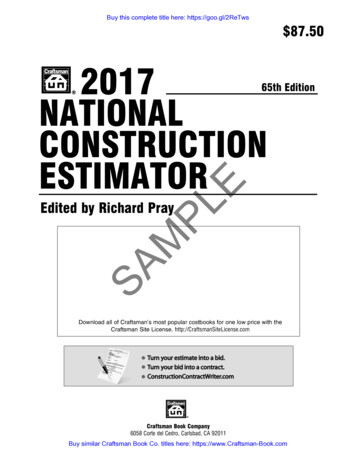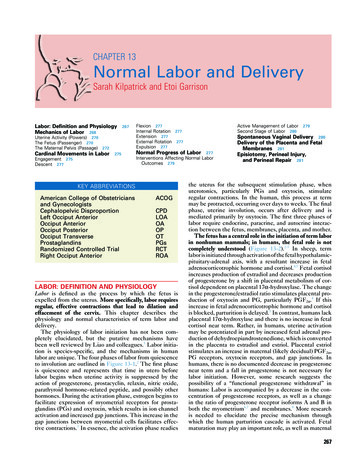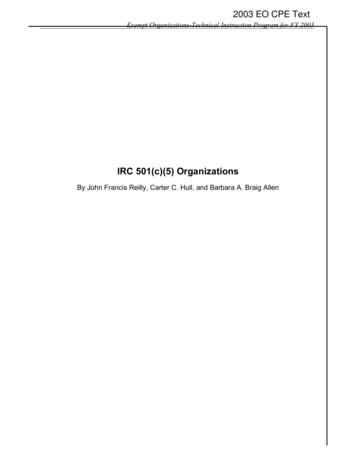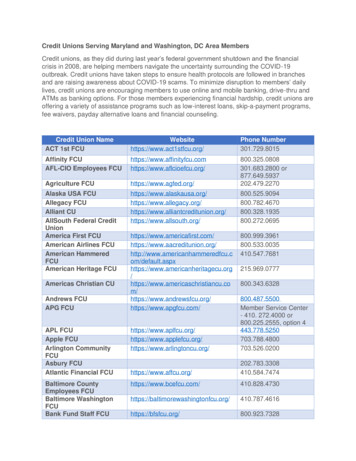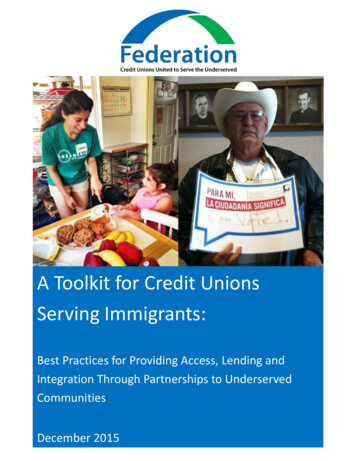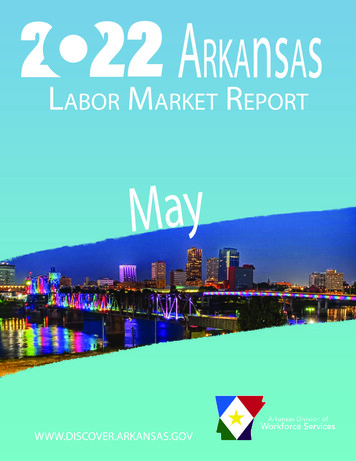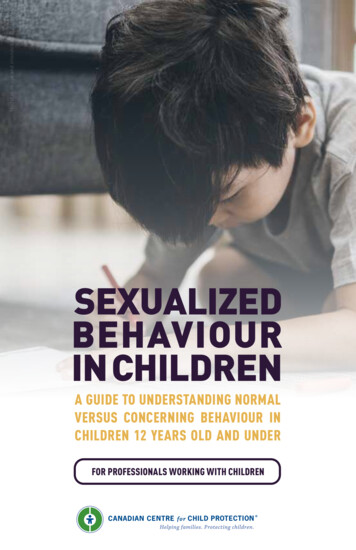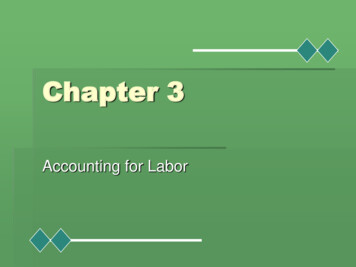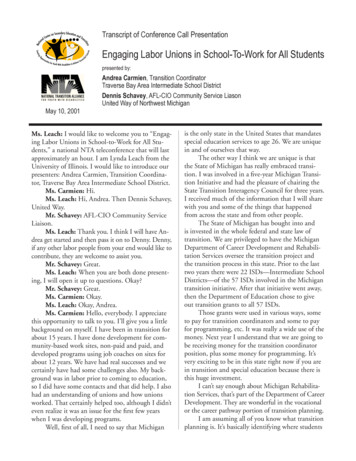
Transcription
Transcript of Conference Call PresentationEngaging Labor Unions in School-To-Work for All Studentspresented by:May 10, 2001Andrea Carmien, Transition CoordinatorTraverse Bay Area Intermediate School DistrictDennis Schavey, AFL-CIO Community Service LiasonUnited Way of Northwest MichiganMs. Leach: I would like to welcome you to “Engaging Labor Unions in School-to-Work for All Students,” a national NTA teleconference that will lastapproximately an hour. I am Lynda Leach from theUniversity of Illinois. I would like to introduce ourpresenters: Andrea Carmien, Transition Coordinator, Traverse Bay Area Intermediate School District.Ms. Carmien: Hi.Ms. Leach: Hi, Andrea. Then Dennis Schavey,United Way.Mr. Schavey: AFL-CIO Community ServiceLiaison.Ms. Leach: Thank you. I think I will have Andrea get started and then pass it on to Denny. Denny,if any other labor people from your end would like tocontribute, they are welcome to assist you.Mr. Schavey: Great.Ms. Leach: When you are both done presenting, I will open it up to questions. Okay?Mr. Schavey: Great.Ms. Carmien: Okay.Ms. Leach: Okay, Andrea.Ms. Carmien: Hello, everybody. I appreciatethis opportunity to talk to you. I’ll give you a littlebackground on myself. I have been in transition forabout 15 years. I have done development for community-based work sites, non-paid and paid, anddeveloped programs using job coaches on sites forabout 12 years. We have had real successes and wecertainly have had some challenges also. My background was in labor prior to coming to education,so I did have some contacts and that did help. I alsohad an understanding of unions and how unionsworked. That certainly helped too, although I didn’teven realize it was an issue for the first few yearswhen I was developing programs.Well, first of all, I need to say that Michiganis the only state in the United States that mandatesspecial education services to age 26. We are uniquein and of ourselves that way.The other way I think we are unique is thatthe State of Michigan has really embraced transition. I was involved in a five-year Michigan Transition Initiative and had the pleasure of chairing theState Transition Interagency Council for three years.I received much of the information that I will sharewith you and some of the things that happenedfrom across the state and from other people.The State of Michigan has bought into andis invested in the whole federal and state law oftransition. We are privileged to have the MichiganDepartment of Career Development and Rehabilitation Services oversee the transition project andthe transition process in this state. Prior to the lasttwo years there were 22 ISDs—Intermediate SchoolDistricts—of the 57 ISDs involved in the Michigantransition initiative. After that initiative went away,then the Department of Education chose to giveout transition grants to all 57 ISDs.Those grants were used in various ways, someto pay for transition coordinators and some to payfor programming, etc. It was really a wide use of themoney. Next year I understand that we are going tobe receiving money for the transition coordinatorposition, plus some money for programming. It’svery exciting to be in this state right now if you arein transition and special education because there isthis huge investment.I can’t say enough about Michigan Rehabilitation Services, that’s part of the Department of CareerDevelopment. They are wonderful in the vocationalor the career pathway portion of transition planning.I am assuming all of you know what transitionplanning is. It’s basically identifying where students
NCSET / NTA Teleconference Transcript / May 10, 2001are going to live, work, integrate into the community, and what they are going to do for social/leisure.That’s the bottom-line and simple way to explainthe law—you can imagine all the complications if Iwas actually reading you the law.In Northern Michigan, we do not have manyfactories. Denny will share with you the number ofunions that we do have. We are not like Lansing,Flint, or Detroit that have all these huge unions andthe automotive industry, etc. However, I think thereare pros and cons. I think sometimes in the biggerunions you probably can get more support than wecan in some smaller unions.Back years ago when I was first developing vocational programs, we decided that with the studentpopulation we were serving that we needed to givethem a minimum of nine work experiences in thecommunity with an evaluation process linked to it.After the nine work experiences they were ready forcompetitive employment. We had an 80% placement rate at that time through this one program.Well, in doing this, in developing jobs, whatI would do—I had three job coaches and each ofthe job coaches were assigned to a business for theentire year, so we worked with three employers. Asyou guys have probably heard or done, many peoplego out to businesses and ask if they would please letsome students with disabilities or special educationstudents come in and do something within theirbusiness. The way we chose to approach this issuewas we always went to employers and told them wewere interviewing employers and we would choosethree employers. Then we would move our sitesaround every year or every two years so we didn’tsaturate any one business in the area. The other benefit to that is building community education withinthe community on people with disabilities. I workedwith quite a few placement agencies, includingManpower and those agencies. When we were donein a workplace, I would then let these people knowthat we were not going to come back the followingyear and they could very easily place people withdisabilities in that business because the co-workersunderstood how to work with people with disabilities; they had been educated by the on-site job coachduring that school year. That’s how we were started.My first encounter with the union at thattime was with our community college. We wanted to develop a site in the cafeteria area of our community college. When I talked to the manager ofthat department, he never mentioned there was aunion involved. By the time we talked to them andthey wanted to do the program and I brought thejob coach in to do some job development, we veryquickly found out that there was a union in place.There were a couple of the union people that werenot real happy about it because they were afraid wewould displace workers. At that point we backed offa little bit and the job coach and I were able to setup a meeting to present our program to the staff.From there we had to meet with the union business agent; and then from there ended up goingto their union board and presenting the program.We finally received the okay to set up our non-paidwork experience site.I think that some of the benefits obviously arethat our students became familiar with unions. Theother thing we promised them was that within ourschool curriculum we would provide informationabout unions, what a union was, how they worked,what union dues were, why there were unions, etc.They felt that it was a way to educate the community on unions also.Probably maximizing community resources,I think we were very well integrated in the community with community resources but not with anyplace that was union. What I found out in conversing with many of people that I worked with fromother agencies is that they didn’t think there wasany hope in working with unions. We don’t evenwant to deal with it because it’s so much trouble,etc. What we found was developing a relationshipwith labor unions was really important.Ms. Shelden: This is Debbie Shelden fromthe NTA. I am was curious if there are other peopleon the call who have also had some experienceworking with unions who would like to share someof their experiences?Ms. Burns: In Pennsylvania we are workingon registered apprenticeships. I work in educationdirectly with labor and industry and the U.S. Department of Labor. We have opened up registeredapprenticeships in the state to age 16 and above. Wehave been doing this since ’98 and we are havingtremendous success including labor unions in developing apprenticeships and adding front pieces that
Engaging Labor Unions in School-To-Work for All Studentsare more specific to the 16- to 18-year-olds that arealso part of the actual registered apprenticeship.Ms. Shelden: Are they students with disabilities?Ms. Burns: We are working very hard to promote opportunities. For example, one corporationis currently writing apprenticeships for their targetpopulation who are young people with disabilities.We are mostly promoting and working with transition coordinators. In fact, in some places the state islooking at registering apprenticeships to standardizethe training for their paired professionals, such as jobcoaches, which requires everyone to have a nationallystandardized set of skills and work process and wouldgive them a credential at the end of that training. Wethink that will address many of the concerns withinequities and training of our paired professionals.We are doing some exciting things in Pennsylvania.If you would like to contact me, RebeccaBurns, my direct line is (717) 772-0867. And myemail is rburns@state.pa.us. I can try to get youlinked up with various sponsors and some of the activities that are going on. I invite you all to visit usand I would love to be able to talk individually withyou guys and see if I can’t make some connections.Ms. Shelden: Rebecca, this is Debbie Sheldenagain. I was wondering when you started the program up in ’98, were there any particular barriersthat you encountered that you have been able toovercome that you could share some strategies for?Ms. Burns: There were many barriers. Mostof the barriers were perceived rather than real. Ithink the beauty of working through the barriersis the labor and industry working with education.They know the universe of the union and unionissues because labor and industry were able to workthrough any barriers under labor law issues, and under apprenticeship issues. I had experience with theeducational community so together we have workedas problem-solvers, identifying inconsistencies inpolicy, even learning to speak each other’s languageand understand what it means. We have worked inconcert and are continuing to do so as far as identifying issues and resolving those issues for the sponsors, the schools, the children, whomever. That’swhy it’s working so well.I won’t tell you that it hasn’t been tough, butwe are all advocates and we are breaking downbarriers. We have been working hard jointly andI think that’s the key to what we have done—isthat we each are basically experts in our own area.Therefore, we are working together to say, youknow, this really isn’t something that’s in our way.For example, under child labor law if you are partof a registered apprenticeship then you receiverelease from some of the prohibited activities. Thosetypes of things we have worked through togetherthat address concerns of industry and unions, as faras their workers’ comp were to go up. We are finding that it’s going down when the young people areentering through such situations.Many of the things that have been historicconcerns, issues, and fears are going away as wework through the processes. It’s ongoing, we arealways problem solving and we are always trying tobrainstorm.Ms. Leach: Is there anyone else who wouldlike to share what they have encountered, any successes or barriers or lessons learned?Ms. Nagrod: This is Janine Nagrod fromthe Washington, DC Central Labor Council. Ourprogram has been working through these schoolto-career initiatives in our city. And we are specifically charged with being the labor intermediary toinvolve the union in the school-to-careers program.It’s a little different. We have a well-established apprenticeship program in this area which wepromote, but that’s not necessarily the boundary ofwhat we do. I think our members want to go intothe schools earlier and start giving the kids optionsearly, not just get them into work situations. Theydo a number of career exploration activities, such asjob shadowing, and they come in and speak to thestudents, stuff like that. We hold an annual unionfair to highlight all the different unionized jobs inthe city and promote labor management cooperation with all of those kinds of activities.Now, our program is fairly new and we arelooking for ways to sustain it. We have receivedmany different options for the future but one of thethings I am interested in hearing is what’s going onin other parts of the country and what works welland know how to do that for the future.Ms. Leach: Okay. Great. Thank you. I thinkit would be nice if anyone else has contact information or Web sites to share about what is going on, so
NCSET / NTA Teleconference Transcript / May 10, 2001that people can then later refer to those; that wouldbe great. Janine, could I get your email address?Ms. Nagrod: Sure. It’s jnagrod@dclabor.org.Ms. Leach: Thank you very much for thatpresentation.Mr. Schavey: I’m the AFL-CIO CommunityService Liaison and I work here at the United Wayof Northwest Michigan. I have worked here forabout 11 years. You have to understand that thereare about 230 to 250 labor liaisons like myselfthroughout the United States who work withUnited Ways. The importance of that informationis that this becomes a good resource for you if youwere to contact your United Way and find out ifthey have a labor liaison. If they do, now you havea connection to where you can find out who theunions are, how you can meet with them, how youcan go to their meetings, how you can get yourprogram implemented in your area.If you don’t have one of those labor liaisons,then you have to understand the national AFLCIO, the American Federation of Labor and theCongress of Industrialized Organizations. It has athree-tier structure:1. There are 67 international unions who are affiliated at the national level. Those are unions, suchas communication workers, steel workers, andmineworkers. Then in addition to those 67, thereare seven trade unions—IBW, pipefitters, andsheet metal workers, those types of unions. Now,you can always make contact at the national levelto find out what’s available or whom you wouldcontact in your local area.2. Then the second tier of the three tiers is thatevery state has a state federation. That statefederation will have affiliates within the state ofthe affiliated unions or international unions thatexist within that state.3. Then there is one final tier, the central laborcouncils and UAW CAP (Community ActionProgram) councils. Those are the local ones thatwould be near your city or near your community, usually a central labor council and UAWCAP council will have a jurisdiction of one tonine, maybe more counties. They cover quitean area. That’s how you would try to find outand make connections and contacts if you don’t have a labor contact. To start, look in the yellowpages; for example, under labor organizations,to find out what central labor council is withinyour area. It is through that central labor councilthat you will have an opportunity to go to theirmeeting. Then they have delegates who come into represent the different international unionswithin that central labor council. Those will beyour local union people.Let me go briefly through the role and function of my job with the United Way and laborunions as a labor liaison. We provide communityservice programs to local union members and thecommunity at large. We provide access to information about services and the different programs,human service programs, in our local areas. We giveinformation on how to access them, how to qualifyfor them. Are there projects people can do for thatorganization? Is there any way someone can volunteer? Is there any way that people can serve on theirboards? We get our union people involved that way.As I have heard, talking to Andrea and listening today, what you need to do if you have a laborliaison, contact that labor liaison within your UnitedWay. If not, then look in your yellow pages andyou’re going to find the central labor council. Whatwe need to have happen is that you educate the localunions and their membership about this program.When we start talking about bringing people intothe workplace, the unions and the members lookat the organization. For example, the organizationManpower, they have temporary people that comein and the next thing you know workers are displaced or laid off because they have found temporaryhelp that will come in and do the same job that theywere doing. The union members have that fear orthat concern right from the beginning so it’s important that you have the opportunity to meet with theunion and educate them about what you’re trying toaccomplish as far as special education students coming into the workplace and getting work experience.You educate those people on what that’s allabout and then you have to reassure and work withthe union before you go to the company. Insist ondrawing up a contract or memo of understanding to reassure the union that the program is notgoing to replace or lay off any existing workers. Ifwe can get that fear subsided, you should have no
Engaging Labor Unions in School-To-Work for All Studentsproblems with the union. The members that are inthat workplace should support your cause becausethis is what unions have been about for over 50years with United Ways. We are here to help peopleimprove their quality of life. One of the ways to dothat, particularly with special education students,is to give them an opportunity to know what thisjob is all about—is it something that they can do,something that they can make their own careers outof and then become a union member. The unionsaren’t going to shy away from getting more unionmembers, and it doesn’t matter if they are specialeducation or anyone else.Ms. Carmien: One of the challenges that wecan come up against is if you find a union in a company and the union and company are not gettingalong well because of personalities or are havingother conflicts. Many times you don’t know whatthose reasons are. There have been times that wehave really backed off and literally waited until thatposition changed to be able to see if we could workwith that person better.We were also in a situation once that we wereused as a pawn between the business and the union.It was our big medical center. We chose to backright out of that because we didn’t want to causeany more problems.The other piece to this is you have to ask yourself what are they going to get out of this. It’s not justwhat is the business going to get out of this but whatis the union going to get out of this. Denny alludedto that a little bit. Part of that is public relations.Many times unions do not get a good rap, at least uphere in our Republican conservative town. What wedo when we set up work sites is I invite the newspaper and the television people to go with me on a sitevisit. I make sure that the union reps are there on sitewhen we get there so we can introduce them, etc.We push that to make sure it’s included in the articleor included on the news. Once that happens, therearen’t many union people that aren’t just thrilled tohave received good PR. I think that’s important.I understand that all states don’t have Intermediate School Districts and I just want to make apoint of saying that our district covers five countiesand 15 local school districts and about 2,200 squaremiles geographically. We have a very large area. Asyou probably know, it’s laid out around the greatlakes, around the bay. Geographically it’s difficult tocover that much distance. We do the best we can.Sometimes the labor liaison that is in the position that Denny is in, that person might be difficultto get on your side. What you have to do is let themknow what they could get out of it and let them bethe lead person that would get credit for getting thisestablished.The number one piece of advice I would givewould be to find out somehow what the relationship is between labor and that employer. Thecommunity service liaison, many times, will be realhonest with you and say, stay away from here, butyou might get in there, and give you some of thedemographics of the people on who you can getalong with better and who would be more open tolooking at something like that. We find in worksites that there are employees that are very open toworking with students with disabilities and there arepeople who don’t want anything to do with them.The other issue that we do a little bit more inunionized places is we really respect mentorships.Many times the job coach will work with a coworker to educate them on how they can supportand help the person with disabilities. Then they cantake the lead and help them when the job coachdoes step back a little bit and so on. That reallyenriches the whole experience.The other thing is, you can get in the labornewsletter. That really goes out of the central laborcouncil. I presented at Denny’s community serviceclasses. That way you can get a real conceptionof union people. By and large, the bottom line is,“Don’t take our jobs.”Ms. Leach: Right. Well, it sounds like it reallypays to find out who the local labor liaison is inyour community.Mr. Schavey: It’s very important. If it’s available to you, it’s a key to start with. They know andalready have a relationship with all the local unions.Ms. Carmien: It’s amazing how few transition coordinators even think about unions. I knowthat there are agencies like rehabilitation service ora voc-rehab place or whatever; many times they willtalk about unions. School systems are usually thepath of least resistance.Ms. Leach: Right. Before I open it up to questions, Andrea, would you please give us your con
NCSET / NTA Teleconference Transcript / May 10, 2001tact information for those on the line who wouldlike to, at some later point, maybe email you or callyou and Denny?Ms. Carmien: Sure. My email is acarmien@tbaisd.k12.mi.us. My phone number is (231) 9226374.Mr. Schavey: Our Web site is www.tbaclc.org.Ms. Carmien: I’m curious what questionsthere might be or if there is something you didn’tunderstand or you would like us to elaborate on.Ms. Leach: Any questions from those who areout there for Denny and Andrea?Ms. Steigerwald: This is Marcia Steigerwaldin Indiana. It’s not a question. I just want to offer upa piece of information that is related to this topic.There is wonderful videotape available through thePACER Center on Natural Supports in a UnionWorkplace. Now, this is an actual job placementthat was carved in a union shop for an individualwith a disability. It shows the process that the groupwent through in terms of developing the relationship with the union, developing the actual job site.I don’t have that information with me where I amright now. Lynda, maybe you can provide some contact information at your fingertips. I have found itvery helpful when we have been talking with peopleon job development for people with disabilities inunion workplaces. It was shown a couple of yearsago at the National Systems Change Project andTransition National Directors Meeting. PACER previewed it there and I think it’s available for a nominal fee. [Editor’s Note: See http://www.pacer.org/publications/transition.htm for more information.]Ms. Leach: Great. Thanks. Anyone else?Ms. Nagrod: This is Janine Nagrod. I wantedto mention that there are select central labor councils across the nation that have both had school-towork grants and done some programs or have themnow or have continued some programs. It may notbe a totally foreign concept for the central laborcouncils. That is where, you know, you can lookup in your yellow pages and find that central laborcouncil. I think Denny was right before when hesaid that’s where you should start.Ms. Steigerwald: This is Marcia in Indianaagain. You’ll find central labor council representation on many of the local partnerships. I know inthis area the local partnership is represented on the school-to-work labor council.Ms. Carmien: I’m curious, have the programsbeen successful with unions and school systems?Were they non-paid or paid?Ms. Steigerwald: I think each program hasvaried in what it has concentrated on and what ithas provided. There is a program running up inNew England that is a paid summer internshipprogram with a single employer. There is a mentorprogram that was running in Iowa. A different summer program was in Seattle. Here we are in a fairlyunique role as we are written into a school-to-careerinitiative grant as an intermediary to labor. And ourprogram is much more varied because of that.Each place has had varying degrees of successand some have continued and some have been givenmoney to duplicate themselves in other places. Forinstance, the one up in New England is like that. I’mnot sure that I can speak to their successes or failures, but there are many different models out there.Ms. Carmien: I really believe that everybodyhas to get something out of it. If you can identifythat for the school program and for the union andfor the employer, it’s threefold.Ms. Steigerwald: I think the other importantthing to note is, in any kind of coalition, that youdo identify up front for everybody what everybody’sinterest in it is and what they hope to get out of itso that it’s clear. When things start getting rough, noone says, “Well, we didn’t know that you’re lookingfor union members to get out of this so you wantthem to be organized in the future.” As long as everyone lays it out on the table at first, then it’s niceand clear and there are no problems down the road.Ms. Carmien: I think one place that Michiganhas problems is in the factories that are like production lines. Many students with disabilities can’t keepup with production. If they can, and schools haveplaced them in a non-paid situation on occasion,then the unions certainly have the right to get reallyupset because they could displace somebody. Theunions we have up here and the ones I have dealtwith have not been factory production line typeenvironments.Mr. Schavey: We’re not highly industrializedin Northern Michigan.Ms. Sword: This is Carrie Sword at the University of Minnesota. One of the speakers earlier
Engaging Labor Unions in School-To-Work for All Studentsmentioned that you found that policy was moreof an issue than laws. I’m wondering what kind ofpolicy issues with the employers have you foundthat at first seemed difficult or impossible?Ms. Carmien: Were we talking about an agreement between the school program and the employer?Ms. Sword: I think you were talking aboutagreements between the school program and theemployer.Ms. Carmien: Well, I know we have writtenagreements with the employers. If there is a unioninvolved we write that into the agreement and havethe union representative sign that agreement.Mr. Fleeter: This is Al Fleeter calling fromCedar Rapids, Iowa. I have served for the past fiveyears as a regional school-to-work coordinator inour seven-county area. It is an intermediate schooldistrict situation and, as somebody was wondering,I understand that approximately half the states haveintermediate school districts. A community college person and I have been serving as co-chairs ofa substate regional partnership that includes about6,500 students. We have, I feel, been blessed andenriched with union participation in that partnership. Our purpose is to support and build capacity in school-to-work among our local 33 schooldistricts and their communities.Now, some of this may be quite familiar toyou, but one of the things that we have had in ourstate is a person, Jan Smith, who distributed a guidebook. It’s from 1997, but I would guess that thereis current information in it, involving unions andschool-to-work initiatives. Is that familiar to you?Ms. Carmien: Not to me, no.Mr. Fleeter: It’s an AFL-CIO publication. Iassume it is published by the Human ResourcesDevelopment Institute of AFL-CIO.Ms. Carmien: That is now called Workingfor America. They have changed their name. I amnot sure if they are publishing it anymore. They didthat when they had a school-to-work grant, whichhas expired. You can call the AFL and ask for Working for America Institute.Mr. Fleeter: Okay. That has been useful. Theexpiring of school-to-work or the sunsetting of theSchool-To-Work Opportunities Act might be something that we can bring into the conversation, too.I’m not pretending to speak for the whole state, butthere are a couple of things that have been useful.Probably the main one recently has been our laborcouncil has worked to bring in collective bargaining negotiations and conflict resolution trainingfor students. That has, I think, had multiple application besides collective bargaining, good common-sense problem solving, and conflict resolution,which, you know, we see as employability skills.That’s been something that our labor council hassupported disseminating.Mr. Schavey: This is Denny. I have one morecontact for you. I heard the gentleman that wastalking about Working for America with the AFLCIO? I have a phone number and the contact andtheir Web site, if you would like that. It’s AFL-CIOWorking for America Institute, Bruce Herman,Executive Director, (202) 638-3912. The Web siteis www.workingforamerica.org.Ms. Leach: Thanks, Denny. Andrea and Denny, I do appreciate all the time you spent gettingready for this call. It sounds like Northern Michiganhas developed a number of good relationships withunions and had many good outcomes for students.Ms. Carmien: I would like to mention onelast thing, Lynda, and that is that in our state somebody mentioned school-to-work initiative sunsetting. I just want to say that in Michigan we havetaken on the initiative of career preparation thathas taken over the school-to-work initiative. Thestructure in the state is set up and conducive to thatsystem, so there is a really big buy-in into careerpreparation right now in the
Dennis Schavey, AFL-CIO Community Service Liason United Way of Northwest Michigan May 10, 2001 Ms. Leach: I would like to welcome you to "Engag-ing Labor Unions in School-to-Work for All Stu-dents," a national NTA teleconference that will last approximately an hour. I am Lynda Leach from the University of Illinois. I would like to introduce our

